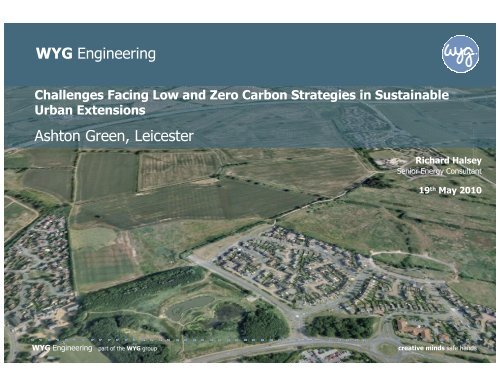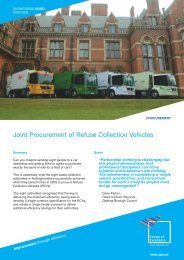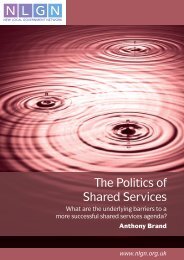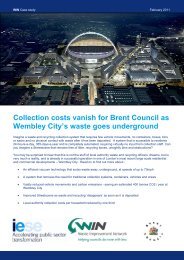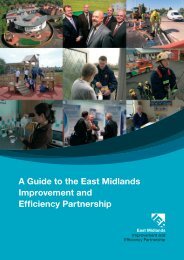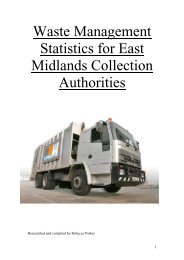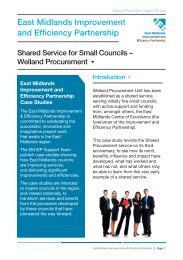Ashton Green, Leicester - East Midlands Improvement and Efficiency ...
Ashton Green, Leicester - East Midlands Improvement and Efficiency ...
Ashton Green, Leicester - East Midlands Improvement and Efficiency ...
You also want an ePaper? Increase the reach of your titles
YUMPU automatically turns print PDFs into web optimized ePapers that Google loves.
WYG Engineering<br />
Challenges Facing Low <strong>and</strong> Zero Carbon Strategies in Sustainable<br />
Urban Extensions<br />
<strong>Ashton</strong> <strong>Green</strong>, <strong>Leicester</strong><br />
Richard Halsey<br />
Senior Energy Consultant<br />
19 th May 2010<br />
WYG Engineering part of the WYG group<br />
creative minds safe h<strong>and</strong>s
Key Drivers <strong>and</strong> Challenges<br />
• Making new housing stock more efficient <strong>and</strong> less carbon<br />
intensive now takes a central role in policies to reduce UK carbon<br />
emissions.<br />
• Recent history of carbon reduction policy in housing is constantly changing<br />
• The government is committed that new homes be Zero Carbon by 2016.<br />
• 3 million new homes forecast by 2020 means this is a major challenge<br />
• large-scale Zero Carbon delivery in Britain is unproven<br />
• The Zero Carbon commitment raises a multitude of questions, regarding<br />
the priorities of social, economic <strong>and</strong> environmental objectives<br />
WYG Engineering part of the WYG group<br />
creative minds safe h<strong>and</strong>s
<strong>Ashton</strong> <strong>Green</strong><br />
• <strong>Ashton</strong> <strong>Green</strong> is a 130ha <strong>Green</strong>field site near Beaumont Leys<br />
• Proposed to deliver 3,000 new homes, employment <strong>and</strong> community l<strong>and</strong><br />
• Phased build programme is estimated at 20 years<br />
• Delivery via multiple development partners <strong>and</strong> house builders<br />
• Outline Planning Application to be submitted this year<br />
• Sustainable energy has been at the heart of aspirations for the site<br />
• The One <strong>Leicester</strong> vision aims for Zero Carbon homes <strong>and</strong> buildings<br />
• Development Faces challenging economic climate <strong>and</strong> needs to balance<br />
social, environmental <strong>and</strong> economic concerns to deliver sustainable<br />
development<br />
WYG Engineering part of the WYG group<br />
creative minds safe h<strong>and</strong>s
Approaches to Sustainable Housing<br />
• Delivery of Low <strong>and</strong> Zero Carbon housing is now a key aspect of the<br />
future regulation of house building.<br />
• The Zero Carbon st<strong>and</strong>ard is incorporated into the Code for Sustainable Homes<br />
(The Code) which is the national st<strong>and</strong>ard for sustainable new homes<br />
• The Code measures the sustainability of a new home against nine categories<br />
summarised in a rating system that goes from 1 to 6 stars<br />
• Minimum st<strong>and</strong>ards for energy use is set in relation to carbon emissions at each<br />
level along with a wide range of other sustainability criteria<br />
• Since 2008 new homes have to be rated against The Code, but this<br />
does not involve as yet any m<strong>and</strong>atory compliance st<strong>and</strong>ard.<br />
• 2010 building regulations require compliance with the energy criteria of Code<br />
Level 3 – a 25% reduction in CO 2<br />
WYG Engineering part of the WYG group<br />
creative minds safe h<strong>and</strong>s
The Zero Carbon Goal<br />
• What is a Zero Carbon home?<br />
• The Government’s definition of a Zero Carbon home remains:<br />
• “Net annual carbon dioxide emissions, taking account of emissions<br />
associated with all energy use in the home, is zero”<br />
• The accepted methods for achieving this st<strong>and</strong>ard have recently changed<br />
• Zero Carbon homes must achieve minimum st<strong>and</strong>ards<br />
of thermal energy efficiency set at 46kWh/m 2<br />
• Onsite emissions reduction must meet a minimum<br />
‘Carbon Compliance’ reduction st<strong>and</strong>ard of 70%<br />
• A selection of ‘Allowable Solutions’ can be adopted to<br />
mitigate residual emissions<br />
WYG Engineering part of the WYG group<br />
creative minds safe h<strong>and</strong>s
Zero Carbon at <strong>Ashton</strong> <strong>Green</strong><br />
• 70% reduction in regulated carbon emissions at <strong>Ashton</strong> <strong>Green</strong> is<br />
estimated as equal to a 6,671tonnesCO2/yr reduction<br />
• Minimum performance specification for all space heating <strong>and</strong> dedicated energy<br />
efficient lighting estimated as saving 3,245tonnesCO2/yr (33%)<br />
• Low or Zero Carbon (LZC) technologies<br />
must deliver further<br />
3,677tonnesCO2/yr (38%) reduction<br />
• Allowable solutions must offset further<br />
5,512tonnesCO2/yr<br />
<strong>Ashton</strong> <strong>Green</strong> Energy Dem<strong>and</strong> <strong>and</strong> Carbon<br />
Emissions Summary<br />
No of Dwellings<br />
Non-Residential<br />
Total Energy<br />
3,000<br />
63,900<br />
36,111<br />
Dwellings<br />
m2<br />
MWh/yr<br />
Regulated CO 2<br />
6,286<br />
TonnesCO 2<br />
/yr<br />
Total CO 2<br />
9,912<br />
TonnesCO 2<br />
/yr<br />
WYG Engineering part of the WYG group<br />
creative minds safe h<strong>and</strong>s
Role of Low <strong>and</strong> Zero Carbon Technologies<br />
• LZC technologies are an essential part of any low <strong>and</strong> zero<br />
carbon energy strategy<br />
• An estimated 38% reduction in CO2 will need to be achieved at<br />
<strong>Ashton</strong> <strong>Green</strong> by LZC technologies<br />
• Challenge of balancing the carbon benefit of technologies against the<br />
environmental, economic <strong>and</strong> operational impact of different LZCs to<br />
ensure a sustainable solution is achieved.<br />
WYG Engineering part of the WYG group<br />
creative minds safe h<strong>and</strong>s
<strong>Ashton</strong> <strong>Green</strong> Building Integrated Technologies<br />
Technology<br />
Technical <strong>and</strong> Site<br />
Suitability for Residential<br />
Occupant Practicality<br />
Developer<br />
Affordability<br />
Solar Water Heating<br />
High<br />
High<br />
High<br />
PV<br />
High<br />
High<br />
Low<br />
Ground <strong>and</strong> Air Source Heat<br />
Pumps<br />
Maybe<br />
High<br />
Medium<br />
Solar Air Heating<br />
Low<br />
Low<br />
Low<br />
Individual Dwelling Biomass<br />
Heating<br />
Medium<br />
Low<br />
Low<br />
Domestic Gas CHP<br />
Low<br />
Medium<br />
Medium<br />
Micro Wind<br />
Low<br />
Low<br />
Low<br />
WYG Engineering part of the WYG group<br />
creative minds safe h<strong>and</strong>s
<strong>Ashton</strong> <strong>Green</strong> Site Wide Technologies<br />
Technology<br />
Technical <strong>and</strong> On-Site<br />
Suitability<br />
Practicality<br />
Developer<br />
Affordability<br />
Biomass Heating<br />
High<br />
Medium<br />
Medium<br />
Large Gas CHP<br />
High<br />
High<br />
Medium<br />
Biomass CHP<br />
Medium<br />
Medium<br />
Low<br />
Offsite Heat Recovery<br />
High<br />
Low<br />
Medium<br />
Medium Wind<br />
Medium<br />
Low<br />
High<br />
Large Wind<br />
Medium<br />
Low<br />
High<br />
Micro-Hydro<br />
Low<br />
Medium<br />
Low<br />
EfW<br />
Medium<br />
Low<br />
Low<br />
WYG Engineering part of the WYG group<br />
creative minds safe h<strong>and</strong>s
Constraints to Low <strong>and</strong> Zero-Carbon Technologies<br />
• The sheer pace of change in technologies is a significant<br />
challenge.<br />
• Attempts to promote immature technologies could cause future problems<br />
• Decentralised Energy market is changing rapidly regulation <strong>and</strong> consumer<br />
protection must be considered<br />
• With the possible exception of solar hot-water roof panels, no renewable<br />
energy technology has achieved significant unassisted penetration of the<br />
new build housing market in the UK<br />
• Each technology currently has benefits <strong>and</strong> disadvantages e.g. small<br />
output (micro-wind turbines) or high capital costs (photovoltaic cells)<br />
• Any energy supply strategy for 3,000 homes to be built over 20<br />
years must be flexible <strong>and</strong> adaptive<br />
WYG Engineering part of the WYG group<br />
creative minds safe h<strong>and</strong>s
<strong>Ashton</strong> <strong>Green</strong> Carbon Compliance Energy Scenario 1<br />
Energy Scenario 1<br />
Primary Technology<br />
Solar photovoltaic's<br />
Solar thermal collectors<br />
Heat pump systems<br />
Alternative Generation<br />
Domestic biomass boilers<br />
Micro gas CHP<br />
Micro wind turbines<br />
Location<br />
Individual building <strong>and</strong> dwelling solutions<br />
Delivery mechanism<br />
Zero Carbon Compliance onsite CO2 Reduction<br />
Integrated building design by architect <strong>and</strong> Residual emissions mitigated via allowable<br />
6,493<br />
developers solutions<br />
PV<br />
Energy Scenario 1<br />
Baseline Total Carbon<br />
Emissions<br />
Baseline Regulated<br />
Carbon Emissions<br />
Improved fabric<br />
performance <strong>and</strong><br />
energy efficiency<br />
Solar Thermal Hot<br />
Water<br />
CO 2<br />
Saving<br />
3,245<br />
843<br />
2,575<br />
Total CO 2<br />
13,156<br />
9,531<br />
6,286<br />
5,443<br />
2,868<br />
CO 2<br />
Reduction (%)<br />
34%<br />
9%<br />
27%<br />
70%<br />
WYG Engineering part of the WYG group<br />
creative minds safe h<strong>and</strong>s
Energy Scenario 2 – Building Integrated<br />
Building Integrated<br />
PV<br />
Electricity<br />
<strong>Ashton</strong> <strong>Green</strong><br />
Electricity Dem<strong>and</strong><br />
Building Integrated<br />
Solar Thermal<br />
<strong>Ashton</strong> <strong>Green</strong><br />
Thermal Dem<strong>and</strong><br />
Building Integrated<br />
Heat Pumps<br />
Heat<br />
Local Gas Network<br />
Building driven energy strategy using micro generation systems to achieve targets<br />
can enable easy adaptation of emerging technologies<br />
WYG Engineering part of the WYG group<br />
creative minds safe h<strong>and</strong>s
<strong>Ashton</strong> <strong>Green</strong> Carbon Compliance Energy Scenario 2<br />
Energy Scenario 2<br />
Primary Technology<br />
Gas CHP<br />
Biomass<br />
Low temperature community heat <strong>and</strong> power<br />
infrastructure.<br />
Alternative Generation<br />
EfW<br />
Bio-fuel CHP<br />
Heat recovery<br />
Location<br />
onsite energy centre, thermal storage <strong>and</strong><br />
distribution network<br />
Delivery mechanism<br />
Specialist ESCO via private sector specialist or<br />
public/private joint venture<br />
Gas CHP<br />
Biomass<br />
Energy Scenario 2<br />
Baseline Total Carbon<br />
Emissions<br />
Baseline Regulated Carbon<br />
Emissions<br />
Improved fabric<br />
performance <strong>and</strong> energy<br />
efficiency<br />
Zero Carbon Compliance onsite CO2 Reduction<br />
Residual emissions mitigated via<br />
allowable solutions<br />
CO 2<br />
Saving<br />
3,245<br />
954<br />
2,942<br />
Total CO 2<br />
13,156<br />
9,531<br />
6,286<br />
5,332<br />
2,390<br />
6,015<br />
CO 2<br />
Reduction (%)<br />
34%<br />
10%<br />
30%<br />
74%<br />
WYG Engineering part of the WYG group<br />
creative minds safe h<strong>and</strong>s
Energy Scenario 1 – Decentralised Strategy<br />
Electricity<br />
<strong>Ashton</strong> <strong>Green</strong><br />
Electricity Dem<strong>and</strong><br />
Local Gas Network<br />
Gas CHP<br />
<strong>Ashton</strong> <strong>Green</strong><br />
Thermal Dem<strong>and</strong><br />
Gas Boilers<br />
Heat<br />
Local biomass<br />
fuel source<br />
Biomass Heating<br />
Potential for long term fuel flexibility <strong>and</strong> integration of biomass CHP, EfW <strong>and</strong> heat recovery systems <strong>and</strong> onsite renewables such as PV<br />
WYG Engineering part of the WYG group<br />
creative minds safe h<strong>and</strong>s
The Cost of Sustainable Energy<br />
• Difficult to quantify the long term financial implications<br />
• Different views as to how they are viewed e.g. capital only or whole life costing<br />
• As technological <strong>and</strong> design solutions advance cost of solutions will reduce.<br />
• Costs vary according to specific type, construction <strong>and</strong> location of every dwelling<br />
• Latest published cost research :<br />
Code Level 3: +3% on current build costs<br />
Code Level 4: +11%- £3,000 to £5,500<br />
Code Level 6: +37% - £24,000 to £40,000<br />
• Cost implications could result in a significant impact on l<strong>and</strong> value<br />
• Developers elevated build costs could affect property prices <strong>and</strong> affordability<br />
• Building 3,000 Zero Carbon homes that are unaffordable <strong>and</strong> undesirable<br />
is not sustainable!<br />
WYG Engineering part of the WYG group<br />
creative minds safe h<strong>and</strong>s
Key Barriers<br />
• Many challenges to delivering Zero Carbon homes at <strong>Ashton</strong><br />
<strong>Green</strong><br />
• Uncertainty <strong>and</strong> conflicting agendas regarding carbon reduction<br />
• Changing technological solutions<br />
• Current economic uncertainty <strong>and</strong> adaptability of the development<br />
industry<br />
• Few incentives to developers other than grant funding set against high<br />
capital costs of delivering Zero Carbon homes<br />
• Currently little market premium attached to Low <strong>and</strong> Zero Carbon homes<br />
• Planning framework uncertainty with LDF delays<br />
• Struggling housing market in recession<br />
• Lack of skills <strong>and</strong> technology<br />
WYG Engineering part of the WYG group<br />
creative minds safe h<strong>and</strong>s
Key Decisions <strong>and</strong> Way Forward<br />
• Decisions are needed regarding building integrated or community energy<br />
• A combination of both district <strong>and</strong> building integrated solutions?<br />
• A combination of Low <strong>and</strong> Zero Carbon homes prior to 2016?<br />
• A phased approach to carbon reduction represents a lower financial<br />
impact in current challenging economic circumstances<br />
• Further work should be undertaken by LCC to progress preliminary<br />
scenarios following the outline planning application<br />
• Current <strong>Ashton</strong> <strong>Green</strong> Energy Working Group a potential future forum for<br />
developing the solutions, sharing knowledge <strong>and</strong> informing decision<br />
making<br />
• Carbon Reduction Framework proposed in OPA a mechanism for delivery<br />
WYG Engineering part of the WYG group<br />
creative minds safe h<strong>and</strong>s
WYG Engineering<br />
creative minds safe h<strong>and</strong>s<br />
Thanks for Listening<br />
Any Questions?<br />
Richard Halsey<br />
Senior Energy Consultant WYG<br />
Richard.halsey@wyg.com<br />
0116 2348000<br />
07501157759<br />
WYG Engineering part of the WYG group<br />
creative minds safe h<strong>and</strong>s


